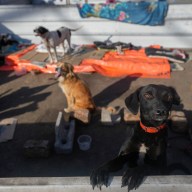PANJWAII DISTRICT, Afghanistan – June got underway Monday with a bang – two of them, actually – for Canadian soldiers deep in the Taliban badlands of southern Afghanistan’s Panjwaii district, more evidence of a seasonal escalation in potentially lethal insurgent activity.
The new month followed one in which Canadian soldiers took only a few minor casualties, including one who was shot clear through the arm but luckily suffered little damage. Another soldier’s eardrums burst as the result of an explosion.
“So far we’ve been quite lucky,” said Maj. Steve Jourdain, commander of a small patrol base, rapping his knuckles on the wooden table in front of him.
“There is a good star shining upon this place.”
Everyone, of course, is hoping the streak of relative good fortune continues. The odds, however, appear to be diminishing.
The end of the poppy harvest means more idle hands, more human fodder for Taliban recruiters to press into battle against Canadian and other international forces fighting to bring stability to the violence-racked country.
“There really is a fighting season,” Jourdain said during an interview at the small base in the Sperwan Ghar subdistrict about 35 kilometres southwest of Kandahar city.
“What I would expect is maybe more direct-fire engagements, more attempts to contact the troops on the ground.”
An increase in insurgent activity has been readily apparent in recent days to those on the base, home to more than 150 infantrymen, along with combat engineers, an artillery troop and members of the Afghan National Army.
The first explosion Monday occurred in a roadside culvert near a patrol base when Canadian soldiers detonated an improvised explosive device discovered by members of the Afghan National Army.
The second blast, which occurred a few hours later, was set off by insurgents who narrowly missed a passing convoy of Canadian military vehicles.
The two blasts were among five incidents in recent days involving make-shift explosive devices near this remote base.
Last week, Canadian troops neutralized an improvised explosive device discovered by Afghan soldiers – a 102-mm artillery shell that was attached by wire to a remote trigger.
It was put there to target Canadians who regularly conduct foot patrols in the area, both as a means of fending off insurgents and trying to win the confidence of villages in the area. Afghan soldiers, of course, are also a favourite target.
On Saturday, Canadian troops uncovered a “daisy chain” – essentially a series of connected explosive devices set about 20 metres apart and running about 90 metres in length. Such a device could have wiped out an entire foot patrol.
As the soldiers secured the area, they came across a man relaying their position by walkie-talkie. They shot him. Another explosive device was also neutralized that day.
“It’s almost a daily business now,” Jourdain said.
In other action, Canadian artillery neutralized three insurgents – although it’s not clear whether they were killed.
The firefight last month in which Pte. Benoit Poulin was shot through his arm led to the arrest of a 19-year-old man carrying four cellphones. The man tested positive for gunshot residue, but whoever fired the damaging shot wasn’t found.
Also, an Afghan National Army patrol hit an explosive device near the base, sparking an intense firefight. One Afghan soldier was killed and two seriously injured.
















